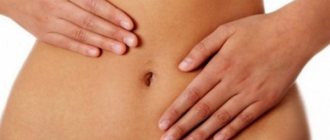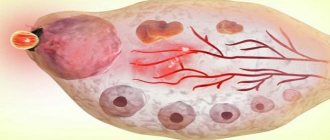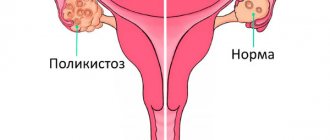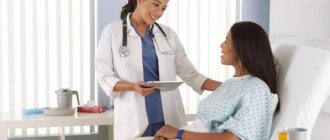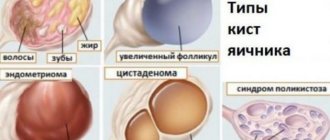The desire to get pregnant sooner or later appears in any representative of the fair sex. For some girls, it is enough to undergo an examination by a gynecologist and have unprotected sex, while for others it is more difficult to conceive, sometimes it is completely unrealistic. But modern medicine has learned to treat diseases in which previously women could not bear and give birth to a child. Doctors are engaged in stimulating ovulation in polycystic ovary syndrome, as well as in other diseases that cause infertility.
Causes of infertility in polycystic ovary syndrome
It is important to distinguish PCOS from ovarian cysts. Polycystic disease affects both ovaries and is accompanied by the appearance of small follicles in the stroma of the organ. A cyst is a single formation filled with fluid. The cyst is often unilateral, less often detected on both ovaries. Some functional formations (follicular and luteal cysts) are prone to spontaneous regression and disappear after menstruation, others can only be treated surgically.
Difference between an ovary with PCOS and a normal state.
The difference between a cyst and polycystic disease lies in the mechanisms of infertility development. With a large cyst, there is a decrease in functional ovarian tissue, damage to the follicles and a decrease in ovarian reserve. Against the background of PCOS, the supply of follicles is preserved, and other reasons lead to infertility.
There are two main factors leading to infertility in PCOS:
- Chronic anovulation. The hormonal imbalance that occurs against the background of polycystic ovary syndrome prevents the maturation of follicles. A large number of small oocytes (up to 10 mm) are present in the ovaries, but none of them becomes dominant ;
- Thickening of the ovarian capsule. Even if the egg matures, it will not be able to exit into the abdominal cavity and meet sperm.
Other conditions accompanying polycystic disease also have an additional impact. Examination often reveals endometrial hyperplasia, a pathology in which excessive growth of the mucous layer of the uterus occurs. The hyperplastic endometrium cannot accept a fertilized egg, and spontaneous miscarriage occurs in the first week after conception. Concomitant hormonal imbalance can cause termination of pregnancy at a later date.
Differences between normal endometrium and hyperplasia.
How and why does PCOS affect the production of female hormones?
Female hormones have a direct impact on the development and maturation of capable eggs that can be fertilized.
During polycystic disease, the content of male hormones in a woman’s body increases, and they suppress female ones. This is the main reason for the impossibility of egg maturation and the lack of ovulation.
The disease is accompanied by a loss of regularity of menstruation, changes are observed in the ovaries, which prevents a woman from becoming pregnant. At the same time, an excess of male hormones significantly changes a girl’s appearance - the skin becomes very oily, acne and dark hairs appear on the face, and the voice becomes rougher.
Reasons why it is impossible to get pregnant with PCOS:
- Lack of ovulation - the egg does not go through the maturation cycle and therefore cannot be fertilized.
- Menstruation becomes irregular, making it impossible to calculate the date of expected ovulation, increasing the risk of missing fertile days.
- It happens that a fertilized egg does not attach to the uterus due to illness.
In order for a woman suffering from polycystic ovary syndrome to become pregnant, the amount of male hormones in the body must be reduced.
Indications for stimulating ovulation in PCOS
Infertility in patients with polycystic ovary syndrome is often secondary. Such women may have a history of one pregnancy that ended in childbirth or miscarriage. The likelihood of spontaneous conception of a child directly depends on the duration of the disease. At a young age, from time to time, follicles in the ovaries still mature, and occasionally full-fledged ovulation occurs. Many women with PCOS are able to conceive on their own before the age of 25.
With age, the frequency of spontaneous ovulation decreases and the ovarian capsule thickens. There are long delays in menstruation up to amenorrhea. After 30 years of age, the likelihood of conceiving a child on your own is extremely low.
To normalize the menstrual cycle and restore ovulation in PCOS, hormonal medications and agents that stabilize metabolic processes are prescribed. Treatment lasts at least six months. If no effect from therapy is observed within 6-12 months and ovulation does not occur, the use of drugs to stimulate it is indicated.
The mechanism of ovulation in normal ovaries and anovulatory cycles in PCOS (schematic representation).
What is ovulation stimulation
This procedure is carried out if the egg is not released, as a result of which the woman is diagnosed with infertility. But it is possible to provoke ovulation with the help of special drugs (Clostilbegit, Puregon, Duphaston, Ovitrel and many others). All medications used for stimulation contain hormones. The only difference is in their type - luteinizing (it supports the development of the female reproductive cell) or follicle-stimulating.
The outcome of the procedure (conception will occur and whether the fertilized egg will implant) is influenced by many factors:
- Patient's age. Scientists conducted a study where it was indicated that, depending on age, the percentage of successful conception decreases: if before the age of 28 the probability of getting pregnant is 90%, at 31 it is already 75%, and if you wait until the age of 41, then even 50%.
Therefore, if you are an older lady and have problems with the reproductive system, consult your gynecologist before planning a pregnancy. The ideal option would be IVF (in vitro fertilization) using a donor cell. This way you can increase the chances of having a baby without pathologies and diseases.
- The reason why there is no ovulation. The scheme that the doctor will draw up depends on the degree of complexity of the disease and how advanced it is.
- Features of the body . If a woman is intolerant to a substance contained in the drug, it should not be prescribed.
What is the essence of the procedure?
Ovulation is the process of the release of an egg ready for fertilization from the ovary. Normally, in a healthy woman this process occurs every month. 1-2 anovulatory cycles per year are allowed. After 30 years, the number of cycles with ovulation decreases.
With polycystic ovary syndrome, the follicles do not mature, and no dominant one is distinguished among them. Ovulation does not occur, and medications are used to stimulate it. Drugs are used that enhance the production of certain hormones and trigger the maturation of follicles. The result is usually superovulation and more than one mature follicle develops.
It is important to know
Ovulation stimulation is triggered no more than 6 times. The use of medications for follicle maturation leads to depletion of the ovarian reserve and infertility. If there is no effect within six months, you need to look for other methods of treatment.
Folk remedies and alternative medicine methods are not used in the treatment of PCOS to stimulate ovulation. The effect was noticed only from hormonal drugs. Other means can be used as an auxiliary measure.
Pregnancy and polycystic disease
You can get pregnant with polycystic disease without treatment, you just have less chance of getting pregnant. Moreover, every year the number of cysts increases, this adversely affects the ovarian tissue, so treatment in order to become pregnant must be carried out as early as possible, since with age the likelihood of conceiving a child becomes even less.
Treatment consists of hormonal correction and ovarian stimulation. If a woman experiences menstrual irregularities, she is prescribed oral contraceptives to normalize it. After their use, periods begin regularly and conception is possible. If pregnancy still does not occur, you can try ovarian stimulation. It is carried out according to various schemes, only under the supervision of a doctor. You cannot take ovulation-stimulating drugs on your own, as this can lead to hyperstimulation, which is dangerous for a woman’s health.
If ovarian stimulation does not help, laparoscopic surgery is possible, during which the cysts are dissected and the dense lining of the ovary is removed, which helps restore blood circulation and normal functioning. Of course, this is a temporary measure, since the cystic changes will form again, but while this happens, the woman’s chances of becoming pregnant increase.
Polycystic ovary syndrome can be eliminated using the following surgical techniques:
- Wedge resection is the excision of androgen-producing ovarian tissue.
- Electrocautery is a low-traumatic procedure that involves destroying tissues that excessively synthesize androgens.
Such operations are now performed using an endoscopic technique - laparoscopy. This is a low-traumatic method of surgical intervention, which is used for both diagnosis and treatment. If polycystic disease is suspected, diagnostic laparoscopy is prescribed. If during the inspection of the abdominal cavity specific changes are detected in the ovaries, the membrane and cystic formations are dissected. The advantages of laparoscopy are that it reduces the risk of formation of adhesions in the abdominal cavity and shortens the rehabilitation period. Often, PCOS is accompanied by adhesions and obstruction of the fallopian tubes. These pathological conditions can be eliminated during laparoscopy.
After a successful operation, ovulation is restored after six months to a year, then the reproductive organs are ready for conception. If pregnancy does not occur after this time, then additional drug therapy is performed. If there is no effect in this case, the best way to get pregnant is to resort to IVF (Read more about in vitro fertilization in this material - note altravita-ivf.ru).
It should be taken into account that when a long-awaited pregnancy occurs after treatment and stimulation, a relapse of polycystic ovary syndrome is possible over a five-year period. Therefore, it is advisable to prevent PCOS after pregnancy, which consists of taking hormonal drugs.
Preparation for the procedure for women with infertility due to PCOS
Before ovulation can be stimulated, the menstrual cycle must be restored. Treatment takes place in two stages:
- Weight normalization;
- Correction of hormonal disorders.
Weight normalization
Weight loss is the first stage in the treatment of PCOS. It has been proven that reducing body weight by 5-10% helps restore the menstrual cycle and trigger spontaneous ovulation. There is no need to achieve an ideal weight. It is enough to change the situation at least a little for the better to increase the chances of a positive result.
It is also useful to read: Laparoscopy for polycystic ovary syndrome
Weight loss is achieved in two ways:
- Diet. For polycystic ovary syndrome, the diet is based on foods with a low glycemic index. Following a diet allows you not only to normalize metabolism, but also to prevent the development of diabetes mellitus, a frequent companion of PCOS;
- Physical activity. Yoga, Pilates, fitness training, running, walking, and water aerobics are recommended. It is important to remember that PCOS is often combined with pathology of the cardiovascular system, and some sports may be contraindicated.
Following proper nutrition and exercise regimen can effectively reduce weight and improve the general condition of a woman with PCOS.
Following a diet and regular physical activity (at least 2.5 hours a week) help normalize hormonal levels and are comparable in effectiveness to the use of medications. In some cases, already at this stage, ovulation is restored and there is no need to use hormonal drugs.
It is important to know
In women with concomitant insulin resistance or diabetes mellitus, metformin is indicated if weight loss cannot be achieved through diet and exercise.
Correction of hormonal disorders
To restore the menstrual cycle in the absence of ovulation, the following drugs are prescribed:
- Combined hormonal contraceptives (COCs, Evra patch, NuvaRing ring). In practice, COCs containing desogestrel, norgestimate, gestodene are more often prescribed according to the 21+7 scheme. Combined drugs suppress the production of LH and androgens, leading to an increase in sex hormone-binding globulin. Against the background of their intake, normalization of the ratio of FSH and LH is noted;
Properly selected COCs can not only restore the cycle, but also reduce the symptoms of PCOS.
- Antiadrogens (spironolactone, cyproterone acetate). Used for severe hirsutism. When using antiadrogens, reliable contraception must be provided;
- Progestogens (progesterone preparations - Duphaston, Utrozhestan and others). Used for insufficiency of the luteal phase from the 16th to the 25th day of the cycle.
If COCs are intolerant, metformin can be used as a second-line drug. The drug reduces the concentration of glucose in the blood and restores the balance of hormones.
The course of drug treatment lasts 6 months. During therapy, the presence of ovulation is determined by various methods:
- Using pharmacy ovulation tests. They are carried out 2 times a day 6 days before expected ovulation. The release of the egg occurs 12-24 hours after receiving the first positive result;
- According to the basal temperature chart. An increase in indicators indicates the maturation of the egg;
- According to ultrasound. Ultrasound examination can track the rate of follicle maturation.
When ovulation starts, you can do without further drug stimulation and achieve pregnancy in the next cycle.
Polycystic ovary syndrome - causes, signs and symptoms
What is polycystic ovary syndrome and what is the development of the syndrome associated with?
Androgens - male sex hormones are produced in small quantities in the female body. Dysregulation of androgen production, increasing their levels in the blood and inside the ovaries is the central mechanism for the development of PCOS - polycystic ovary syndrome. High levels of androgens in the ovaries stop the growth of follicles and the development of the eggs in them. The follicles, being both the source and the victim of increased production of testosterone and other androgens, do not reach maturity and fill the ovary, forming multiple small ovarian cysts (polycystic).
Polycystic ovary syndrome and pregnancy
Ovulation does not occur with polycystic ovary syndrome. The menstrual cycle is disrupted - periods become irregular, delays can be several months. Infertility develops.
External manifestations
An increased amount of androgens in the bloodstream (hyperandrogenism) stimulates hair growth in areas unusual for the female body and the activity of the sebaceous glands, leading to male-pattern hair growth (hirsutism) and the appearance of acne (acne) - the hallmark of polycystic ovary syndrome.
Is there pain with polycystic ovary syndrome?
Not always. With polycystic disease, pain in the ovaries and uterus is possible during menstruation.
Causes of hyperandrogenemia (excess male sex hormones)
There are several genetically determined causes of dysregulation of androgen synthesis:
- increased activity of neuroendocrine structures of the brain that regulate the secretion of luteinizing hormone (LH), which stimulates the functioning of ovarian enzyme systems responsible for the production of testosterone and other androgens;
- high tone of the ovarian enzyme systems involved in the production of androgens, combined with the increased sensitivity of these systems to luteinizing hormone;
- decreased sensitivity of body cells to insulin with a compensatory increase in the basal secretion of this hormone. Insulin, in turn, increases the activity of the above-mentioned enzyme systems of the ovary and brain structures, promoting the secretion of androgens;
- congenital pathology of the adrenal glands (various forms of adrenal hyperplasia) with disruption of the cycle of steroid hormone production and the predominance of those intermediate forms of steroids that have the properties of male hormones.
Increased risk of serious illness
Correction of hormonal and metabolic disorders in patients with polycystic ovary syndrome is of great importance. Along with infertility, more than half of patients with PCOS experience metabolic disorders, the volume of adipose tissue increases, and signs of metabolic syndrome appear with impaired lipid metabolism and a tendency to develop diabetes and cardiovascular diseases. In addition, hormonal disorders in polycystic disease are a risk factor for the development of malignant tumors of the uterus and mammary glands.
Make an appointment {Anchor::title('Diagnostics')}
Drug stimulation of follicle maturation
The ovulation stimulation scheme is selected individually. The first-line drug is clomiphene citrate (Clomiphene, Clostilbegit). It is an anti-estrogen, and its main task is to achieve an increase in FSH, LH and prolactin by reducing estradiol.
Clomiphene citrate is prescribed from the 2nd to the 5th for the menstrual cycle (spontaneous or induced by hormonal drugs). The starting dosage of the drug is 50 mg. If necessary, the dose is increased, but not more than 150 mg per day. Therapy is carried out over 6 menstrual cycles.
Regimen for taking clomiphene citrate to stimulate ovulation.
According to studies, up to 30% of women with PCOS are not sensitive to clomiphene. Several factors have been identified that increase the likelihood of developing clomiphene resistance:
- Age over 30 years;
- Body mass index more than 25 (overweight);
- LH concentration more than 15 IU/l;
- Estradiol level is more than 150 pmol/l.
The effectiveness of the stimulation performed is assessed by ultrasound. A good result is the appearance of 5-10 follicles measuring 18 mm and thickening of the endometrium to 8 mm or more.
In case of resistance to clomiphene, second-line drugs are prescribed - gonadotropins (direct ovulation inducers): Menopur, Pergonal and others. Stimulation begins with a minimum dosage. If there is no effect after a week, the dose is doubled. The duration of therapy should not exceed 6 months.
Ovulation stimulation scheme:
- Taking medications that promote follicle maturation for 5-12 days;
- Monitoring the development of oocytes using ultrasound (on the 11-12th day of the cycle);
- The use of drugs that trigger follicle rupture and egg release (hCG);
- Sexual intercourse or puncture of follicles (in the IVF program) within 36 hours after the administration of hCG;
- Support of the corpus luteum in the second phase of the cycle with progesterone preparations.
Scheme for stimulating ovulation using gonadotropins.
On a note
Conceiving a child against the background of stimulation is possible naturally. If there are obstacles, IVF with follicle puncture, material collection and in vitro fertilization is indicated. On the 3-5th day after fertilization, 2-3 viable embryos are selected and transferred into the uterine cavity.
It is also useful to read: Is it necessary to treat a functional ovarian cyst?
PCOS and clostilbegit
The most common statement made by successful mothers on forums dedicated to infertility problems is “with PCOS, I got pregnant on clostilbegit.” All women who are looking for an answer to the questions “why exactly their family is faced with the problem of infertility and how to solve it” know for sure that this drug gives hope for conceiving a child.
However, few people know what the mechanism of action of this drug is based on and why it cannot be prescribed independently without consulting a doctor.
The drug is available in the form of tablets in a dosage of 50 mg. Has a very fast effect.
Stimulation for PCOS with clostilbegit is used, and is also widely used in the in vitro fertilization protocol to obtain the “superovulation” phenomenon. But it is prescribed exclusively if there is evidence and in no case as an independent appointment by a woman on the advice of friends or participants in Internet forums.
Indications for prescribing clomiphene to accelerate the processes of follicle maturation:
- Presence of a confirmed anovulatory menstrual cycle;
- Amenorrhea of various origins;
- stimulation with clostilbegit for PCOS;
- neoplasms of the brain, namely the pituitary gland, which lead to galactorrhea;
- confirmed oligospermia in males;
For PCOS, stimulation with clostilbegit is prescribed according to certain schemes, which can only be prescribed by an obstetrician-gynecologist.
But it is impossible to simply start taking the drug without prior preparation. This preparation includes mandatory examinations that both women and men must undergo, which can reveal contraindications to stimulation.
For women, it is mandatory to undergo either metrosalpingography or hysterosalpingography - these are all methods that are used to check the patency of the fallopian tubes. As in the first case with the male factor, there is no point in stimulating ovulation if the sperm cannot meet the egg through an obstructed tube. If the levels of certain hormones are elevated. such as prolactin or, conversely, decreased levels of anti-Mullerian hormone. In such cases, “quilting the ovaries” will not give any result.
Clostilbegit for PCOS: reviews, application regimens, results.
The woman needs to find out the regularity of the menstrual cycle: if it is present, then taking the drug begins on the fifth day of the cycle, that is, the fifth day after the start of menstrual bleeding. If there is no regularity in the cycle, then there is no fundamental importance on what day to start taking the medicine.
How to drink clostilbegit further? There are two main directions for dosing and taking the drug.
First scheme: The drug is prescribed 1 tablet once a day for five days. However, during the entire period of taking the drug, as well as after, the doctor must carefully monitor the growth of the follicle. As a result of such therapy, ovulation can be expected on days 11-16 of the menstrual cycle.
Expected effects of treatment
Stimulation of ovulation with first-line drugs (clomiphene) continues for six months. During this period, ovulation should occur and a child should be conceived. After 6 months, the woman is recognized as resistant to clomiphene, and second-line treatments are used.
Before starting therapy, the doctor assesses risk factors and determines the prognosis for stimulation. If there are a large number of negative aspects (age, excess body weight, high levels of LH and estradiol), a woman can be switched to direct ovulation stimulants after 2-3 months of clomiphene therapy.
The effectiveness of ovulation stimulation is up to 75%, but only 15-20% of women manage to get pregnant in the first cycle. In most cases, 2-3 cycles of therapy are required. If first- and second-line drugs are ineffective, the issue of IVF with a donor egg is decided. Surgical treatment is proposed as an alternative.
The following options for laparoscopic intervention are practiced:
- Cauterization of the ovaries - destruction of tissue by electric current or laser;
- Ovarian resection – removal of part of an organ while preserving the ovarian reserve;
- Decortication is excision of the ovarian capsule.
Surgical intervention reduces the volume of the ovaries, stimulates ovulation and ensures the release of a mature egg. At the same time, adhesions are excised and associated causes of infertility are eliminated.
The process of cauterization of the ovaries in PCOS.
Manifestation of polycystic disease
Polycystic disease is one of the most common causes of infertility. With polycystic disease, when the follicle does not rupture, a cyst forms in its place. A large number of such cystic formations further disrupts their function, and women with polycystic disease often experience menstrual irregularities.
Stimulation of ovulation in such patients leads to pregnancy in 70% of cases, so this treatment method is widely used in gynecology. Drugs to stimulate ovulation can be bought at the pharmacy without a prescription, but in no case should you carry out stimulation yourself.
Possible negative consequences of therapy
Stimulation of follicle maturation is carried out with hormonal drugs. While taking them, the following side effects are observed:
- From the nervous system: headaches, attacks of dizziness, depression, insomnia, anxiety, slow reaction speed, blurred vision, unmotivated fatigue;
- From the digestive tract: diarrhea, flatulence, vomiting and nausea, pain in the projection of the stomach;
- From the urinary system: frequent urination;
- Allergic reactions.
The most dangerous complication is ovarian hyperstimulation syndrome. It is accompanied by the appearance of the following symptoms:
- Bursting pain in the lower abdomen;
- Nausea, possible vomiting;
- Flatulence and bloating;
- Shortness of breath, difficulty breathing;
- Reduced urination.
All these symptoms are associated with stretching of the ovarian capsule against the background of the maturation of a large number of follicles and require mandatory medical assistance. For mild hyperstimulation, observation, sexual and physical rest are indicated. In severe cases, inpatient treatment is carried out.
The main symptoms of ovarian hyperstimulation.
Side effects of Clostilbegit
Side effects after taking clomiphene are infrequent and not too bothersome. However, you may experience:
- dizziness or headaches,
- tides,
- temporary vision problems (blurry or double vision, hypersensitivity to light),
- profuse sweating at night,
- breast soreness,
- mood changes,
- feeling of pressure or pain in the abdomen,
- nausea and vomiting.
Clomid is generally considered to be completely safe. Of course, if side effects occur over a long period of time and get worse, the drug should be stopped immediately.
One of the complications when taking this drug may be multiple pregnancies (the risk increases to approximately 5-8%) and ovarian hyperstimulation syndrome. Ovarian histemicity is observed less frequently than with the use of gonadotropins, and, if present, it is in a mild form. There is no significant evidence that treatment with clomiphene increases the overall risk of developing congenital diseases or a particular defect. The number of miscarriages is not increasing. There was no evidence of an increased risk of cancer in women.
The course of pregnancy against the background of polycystic ovary syndrome
Successful stimulation of ovulation and conception of a child do not guarantee a successful pregnancy. Even after therapy, women with PCOS remain at risk for developing obstetric complications:
- Spontaneous termination of pregnancy in the early stages;
- Placental insufficiency and chronic fetal hypoxia;
- Intrauterine growth retardation;
- Gestational diabetes mellitus;
- Preeclampsia with the development of eclampsia;
- Premature birth.
To prevent the development of complications, careful preconception preparation is recommended, including weight loss, giving up bad habits, and treatment of chronic pathology. It is recommended to take vitamins, including folic acid, 3 months before planning pregnancy.
During pregnancy, further progression of the disease does not occur. If the fetus is successfully gestated, childbirth through the birth canal is possible. If complications occur, a caesarean section is performed.
Pregnancy against the background of ovarian hyperstimulation requires careful monitoring and drug correction in the first stages of development.
The prognosis for PCOS depends on the duration of the pathology and the presence of concomitant diseases. The earlier a problem is identified, the easier it is to deal with it. In young women, ovulation stimulation is usually effective. After 30-35 years, the chances of conceiving a child decrease sharply. Untreated polycystic ovary syndrome is one of the leading causes of endocrine infertility in women of late reproductive age.
Diagnostics
Despite the fact that women more often turn to a gynecologist about infertility, upon examination they may notice some symptoms that may suggest polycystic ovary syndrome. In the anamnesis, they note irregularity of the menstrual cycle, scanty or heavy menstruation. Upon examination, a woman with PCOS may be diagnosed with hirsutism, excess male-pattern hair growth. Increased weight and acne that cannot be treated are also signs of hormonal imbalance.
PCOS is diagnosed using the following methods:
- Blood test for hormones.
- Ultrasonography.
- An endometrial biopsy is performed using diagnostic laparoscopy - a biopsy sample is taken for morphological examination. Indications include bleeding outside the menstrual cycle.
- Laboratory blood test.
- Glucose tolerance test.
- Sonography (ultrasound examination) of the pelvic organs is performed transvaginally. In PCOS, the study shows the presence of multiple modified follicles (size up to 10 mm), localized on the periphery, a significant increase in ovarian volume (more than 9 cubic cm), thickened stroma, which makes up a quarter of a percent of the total volume of the ovaries.
Reviews from women about the procedure
The results of drug influence on follicle maturation are different. Analysis of reviews shows that the effectiveness of therapy is largely determined by the woman’s age, the severity of the pathology and the presence of concomitant diseases of the uterus.
Reviews:
I have polycystic disease. Weight is normal, but I haven't had a period for years. There was no ovulation for a long time. The doctor prescribed metformin, and it helped very quickly. I started taking the drug in a minimum dosage, gradually increasing the dose. After 30 days, ovulation occurred. Got pregnant after 2 cycles. Pregnancy 6 weeks.
Anna
PCOS diagnosed at 18 years old. Now I'm 36, no children. They did a laparoscopy, became pregnant on the second cycle after the operation, but had a miscarriage after 3 weeks. After 12 years, I again decided to undergo laparoscopy plus drug stimulation. I’ve been taking Clostilbegit for two months now, hoping for a miracle.
Julia
Polycystic ovary syndrome was diagnosed a long time ago. I tried to get pregnant on my own for a year without surgery or medications - and everything worked out. After giving birth, the diagnosis was removed.
Irina
Useful video about ovulation stimulation: how it happens
How to treat polycystic ovary syndrome?
How to treat polycystic ovary syndrome to get pregnant? Since the main problem with polycystic disease is ovulation, treatment involves its stimulation. The method of therapy is chosen based on the history of the disease. Most often, an integrated approach is used. If a woman is not planning a pregnancy in the near future, she is prescribed a course of oral contraceptives. They temporarily shut down the ovaries, bringing hormones back to normal, thereby regulating the menstrual cycle. After stopping the pills, a rebound effect occurs. It is accompanied by active ovarian activity, which increases the chance of conception.
The best article on stimulating ovulation in skeptic disease.
Cross-section of a healthy uterus
Another method of stimulation involves the gradual administration of hormonal drugs. Before treatment, the following procedures must be carried out:
- Spermogram analysis for a man;
- Checking the patency of pipes using the GHA or UZGSS method;
- Determination of anti-Mullerian hormone levels.
Spermogram
During the first half of the cycle, medications are taken to stimulate follicle growth. From 8-10 days, medications are prescribed that are responsible for the growth of the endometrium. Then they give an injection of hCG, after which the follicle ruptures, releasing the egg out. Ovulation should occur within 24-48 hours after the injection. During this period, sexual intercourse is desirable. The result is confirmed one day after the injection.
Read more about HCG here.
